How to Setup L2tp Vpn on Windows Xp
Client VPN OS Configuration
-
- Last updated
- Save as PDF
This article outlines instructions to configure a client VPN connection on commonly used operating systems. For more information about client VPN, please refer to our Client VPN Overview documentation.
For troubleshooting, please refer to ourTroubleshooting Client VPN documentation.
Android
To configure an Android device to connect to the client VPN, follow these steps:
- Navigate to Settings > Wireless & Networks > VPN
- Click the plus icon to add an additional VPN profile

-
Name: This can be anything you want to name the connection, for example, "Work VPN"
-
Type:selectL2TP/IPSEC PSK
-
Server address: E nter the hostname (e.g. .com) or the active WAN IP (e.g. XXX.XXX.XXX). Hostname is encouraged instead of active WAN IP because it is more reliable in cases of WAN failover. Admin can find them in the dashboard under Security appliance > Monitor > Appliance status.
-
IPSec preshared key: Enter the preshared key that admin created in Security appliance > Configure > Client VPN settings.
-
Click save
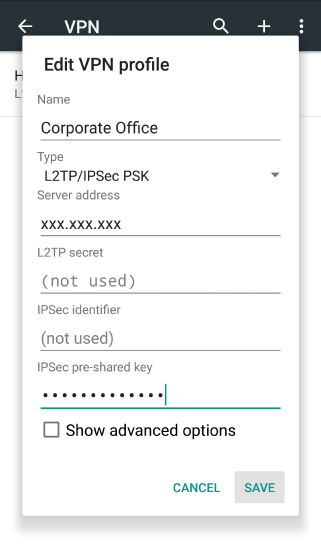
You will be prompted for user credentials when you connect.
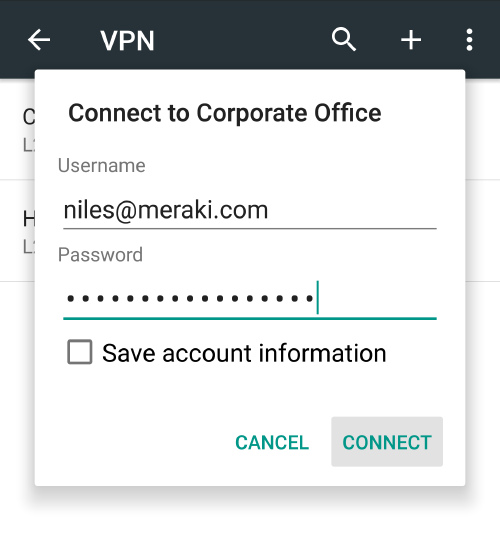
Chrome OS
Chrome OS-based devices can be configured to connect to the client VPN feature on MX security appliances. This allows remote users to securely connect to the LAN. This article will cover how to configure the VPN connection on a Chrome OS device. For more information on how to set up the client VPN feature of the MX, or how to connect from other operating systems, please visit the Client VPN Overview documentation.
- If you haven't already, sign in to your Chromebook.
- Click the status area at the bottom of your screen where your account picture is located.
- Select Settings.
- In the Internet connection section, click Add connection.
- Select Add private network.
- In the box that appears, fill in the information below:
- Server hostname: E nter the hostname (e.g. .com) or the active WAN IP (e.g. XXX.XXX.XXX). Hostname is encouraged instead of active WAN IP because it is more reliable in cases of WAN failover. Admin can find them in dashboard under Security appliance > Monitor > Appliance status.
- Service name: This can be anything you want to name this connection, for example, "Work VPN"
- Provider type: Select L2TP/IPsec + Preshared key.
- Pre-shared key: Enter thes hared secret that admin created in Security appliance > Configure > Client VPN settings.
- Username:Credentials for connecting to VPN. If using Meraki authentication, this will be an e-mail address.
- Password:Credentials for connecting to VPN.
- Click Connect.
For more information regarding the configuration of VPN connections in Chrome OS, visit the Google Support page.
iOS
To configure an iOS device to connect to the client VPN, follow these steps:
- Navigate to Settings > General > VPN > Add VPN Configuration.
- Type: Set to L2TP.
- Description: This can be anything you want to name this connection, for example, "Work VPN".
- Server: E nter the hostname (e.g. .com) or the active WAN IP (e.g. XXX.XXX.XXX). Hostname is encouraged instead of active WAN IP because it is more reliable in cases of WAN failover. Admin can find them in the dashboard under Security appliance > Monitor > Appliance status.
- Account: Enter the username.
- Password: Enter if desired. If the password is left blank, it will need to be entered each time the device attempts to connect to the client VPN.
- Secret: Enter thes hared secret that admin created in Security appliance > Configure > Client VPN settings.
- Ensure that Send All Traffic is set to on.
- Save the configuration.
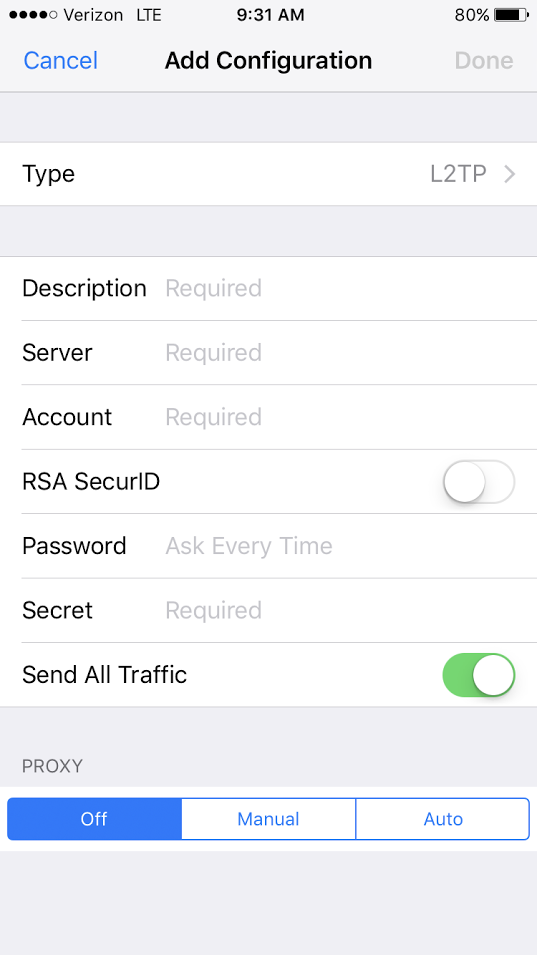
macOS
Currently, only the following authentication mechanisms are supported:
- User authentication: Active Directory (AD), RADIUS, or Meraki-hosted authentication
- Machine authentication: Preshared keys (e.g. shared secret)
When using Meraki-hosted authentication, the VPN account/username setting on client devices (e.g. PC or Mac) is the user email address entered in the dashboard.
The instructions below are tested on Mac OS 10.7.3 (Lion).
Open System Preferences > Network from the Mac applications menu. Click the "+" button to create a new service, select VPN as the interface type, and choose L2TP over IPsec from the pull-down menu.
- Server Address: E nter the hostname (e.g. .com) or the active WAN IP (e.g. XXX.XXX.XXX). Hostname is encouraged instead of active WAN IP because it is more reliable in cases of WAN failover. Admin can find them in the dashboard under Security appliance > Monitor > Appliance status.
- Account Name: Enter the account name of the user (based on AD, RADIUS, or Meraki cloud authentication).
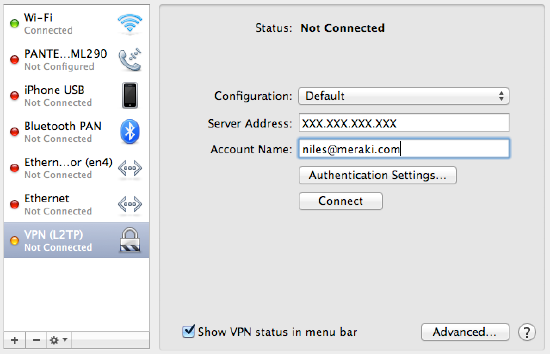
Click Authentication Settings and provide the following information:
- User Authentication > Password: User password (based on AD, RADIUS or Meraki cloud authentication).
- Machine Authentication > Shared Secret: Enter thes hared secret that admin created in Security appliance > Configure > Client VPN settings.

Click OK to go back to the main VPN settings page, then click Advanced and enable the Send all traffic over VPN connection option.
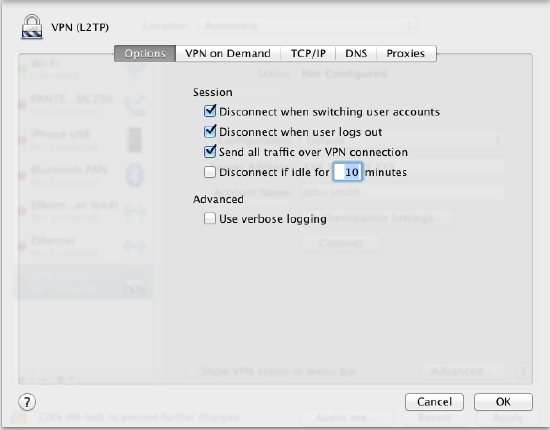
The VPN connectivity will not be established if you don't enable the Send all traffic over VPN connection option.
Windows 7
Currently, only the following authentication mechanisms are supported:
- User authentication: Active Directory (AD), RADIUS, or Meraki-hosted authentication
- Machine authentication: Preshared keys (e.g. shared secret)
When using Meraki-hosted authentication, the VPN account/username setting on client devices (e.g. PC or Mac) is the user email address entered in the dashboard.
Open Start Menu > Control Panel, click on Network and Internet, click on View network status and tasks.
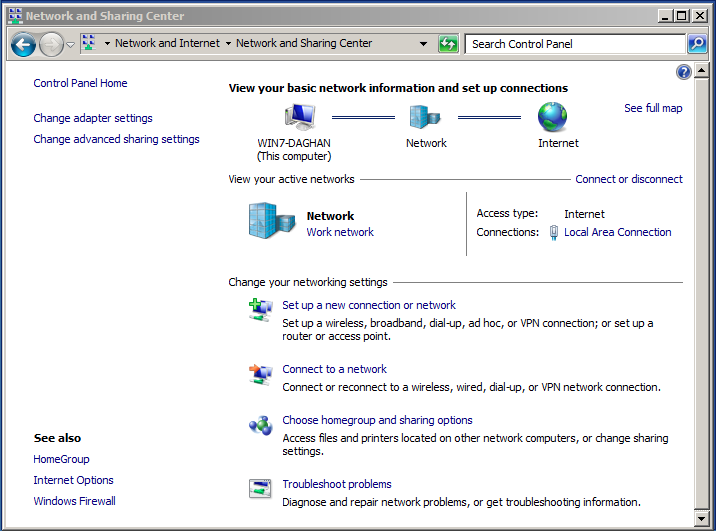
In the Set up a connection or network pop-up window, choose Connect to a workplace (set up a dial-up or VPN connection to your workplace).
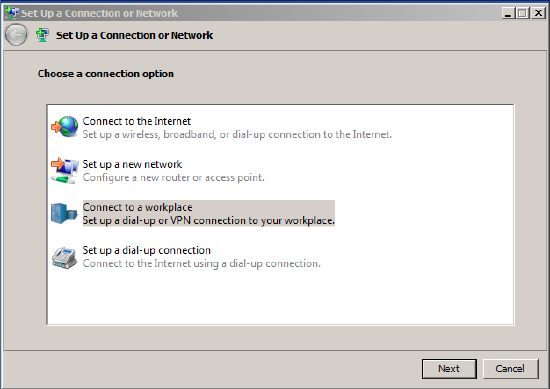
Choose Use my Internet connection (VPN) in the Connect to a workspace dialog window.

In the Connect to a Workplace dialog box, enter:
- Internet address: E nter the hostname (e.g. .com) or the active WAN IP (e.g. XXX.XXX.XXX). Hostname is encouraged instead of active WAN IP because it is more reliable in cases of WAN failover. Admin can find them in the dashboard under Security appliance > Monitor > Appliance status.
- Destination name: This can be anything you want to name this connection, for example, "Work VPN".
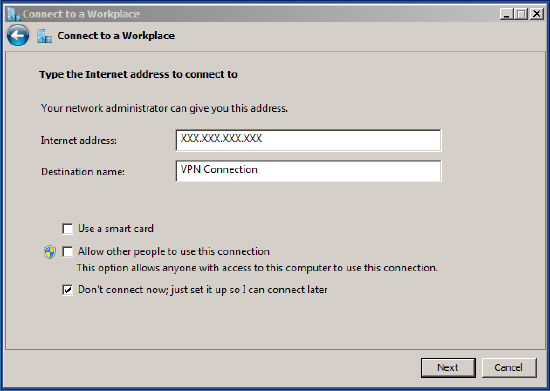
Choose Don't connect now; just set it up so that I can connect later.
Click Next. In the next dialog window, enter the user credentials, and click Create .

Close the VPN connection wizard.
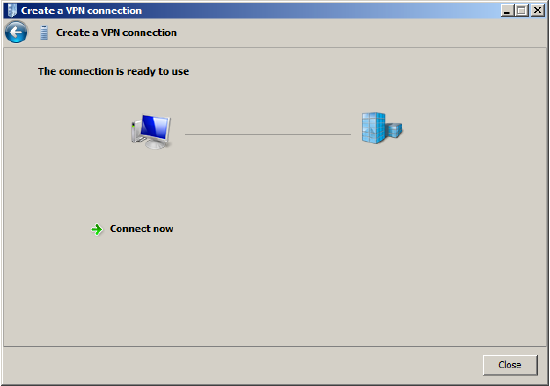
Go to Networking and Sharing Center and click Change Adapter Settings
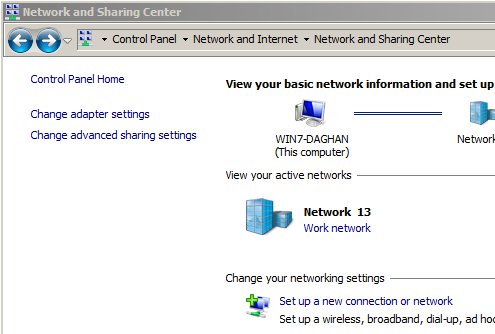
In the Network Connections window, right-click on the new VPN connection settings and choose Properties.
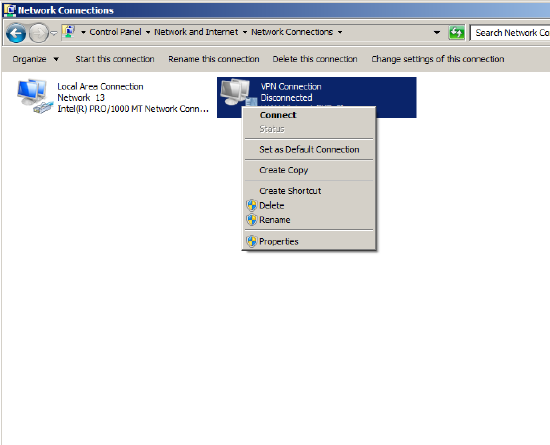
In the General tab, verify the hostname (e.g. .com) or the active WAN IP (e.g. XXX.XXX.XXX). Hostname is encouraged instead of active WAN IP because it is more reliable in cases of WAN failover. Admin can find them in the dashboard under Security appliance > Monitor > Appliance status.
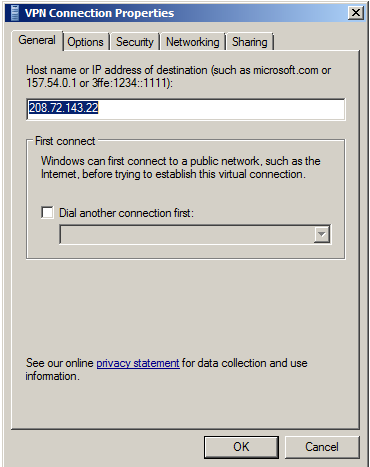
In the Options tab, uncheckInclude Windows logon domain.
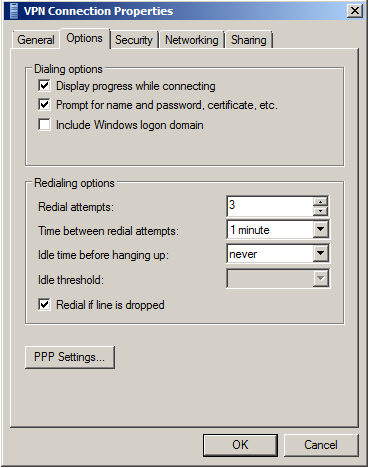
In the Security tab, choose Layer 2 Tunneling Protocol with IPsec (L2TP/IPSec).
Check Unencrypted password (PAP), and uncheck all other options.
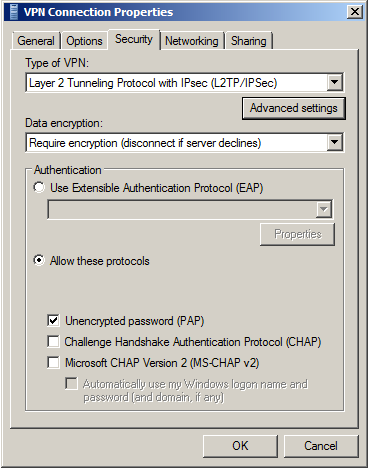
Click on Advanced settings.
Despite the name "Unencrypted PAP," the client's password is sent encrypted over an IPsec tunnel between the client device and the MX. The password is fully secure and never sent in clear text over the WAN or the LAN.
In theAdvanced Properties dialog box, choose Use preshared key for authenticationand enter the preshared key that admin created in Security appliance > Configure > Client VPN settings.
Click OK.
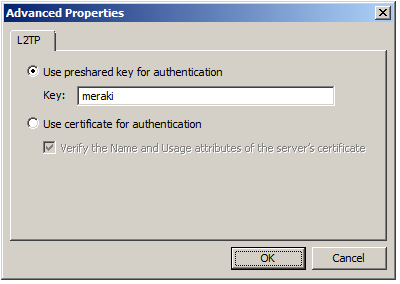
At the Network Connections window, right-click on the VPN connection and click Connect.
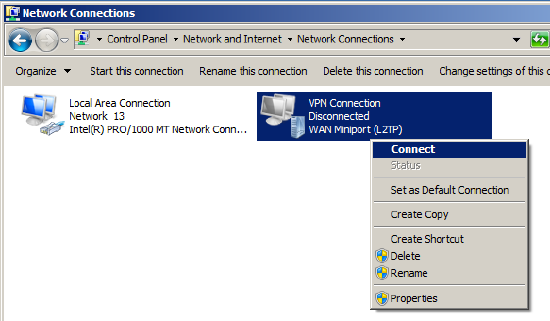
Verify your username and click Connect.
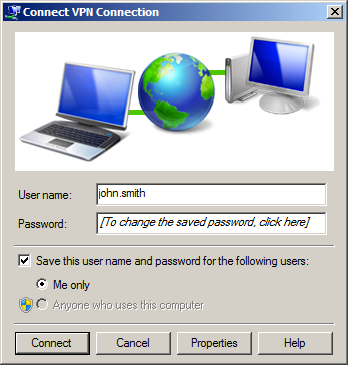
Windows 8
Currently, only the following authentication mechanisms are supported:
- User authentication: Active Directory (AD), RADIUS, or Meraki-hosted authentication
- Machine authentication: Preshared keys (a.k.a. shared secret)
When using Meraki-hosted authentication, the VPN account/username setting on client devices (e.g. PC or Mac) is the user email address entered in the dashboard.
Open Start Menu > Network and Sharing Center and click Settings.
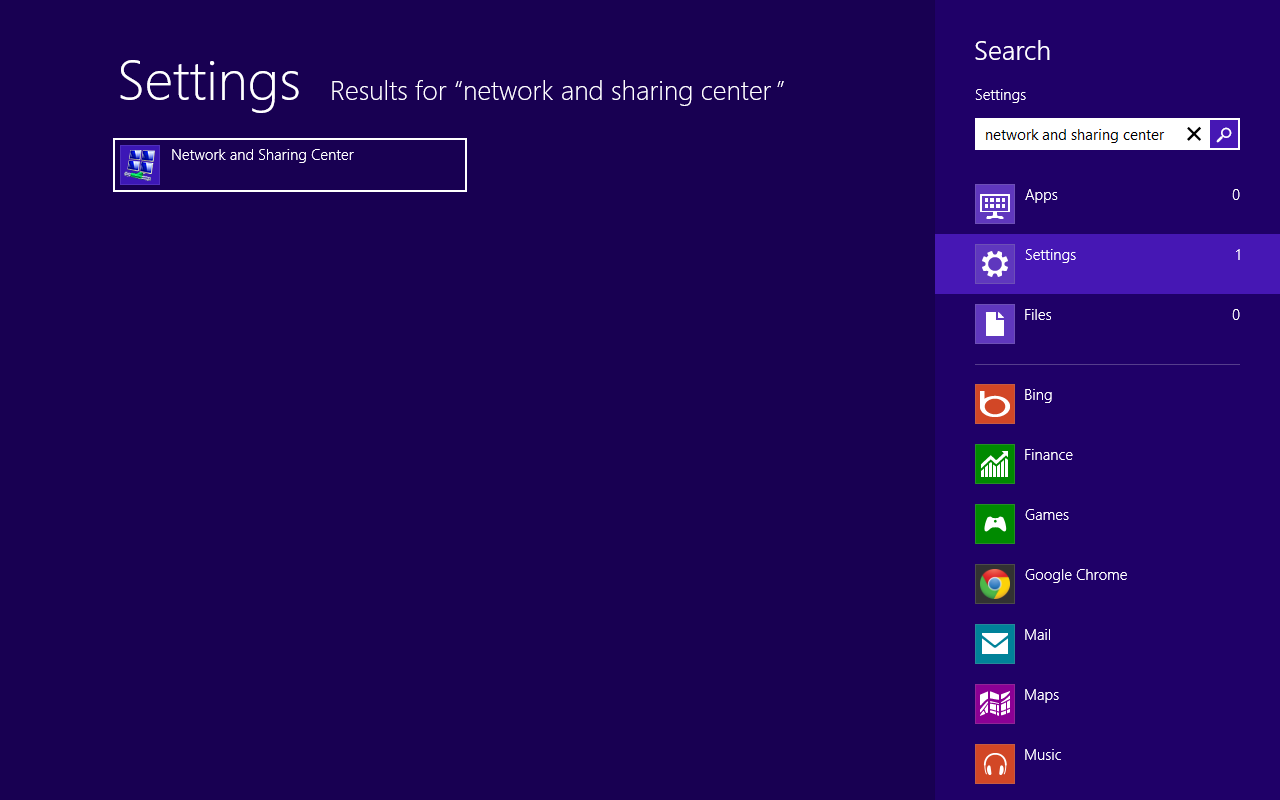
In the Network and Sharing Center, click Set up a new connection or network.
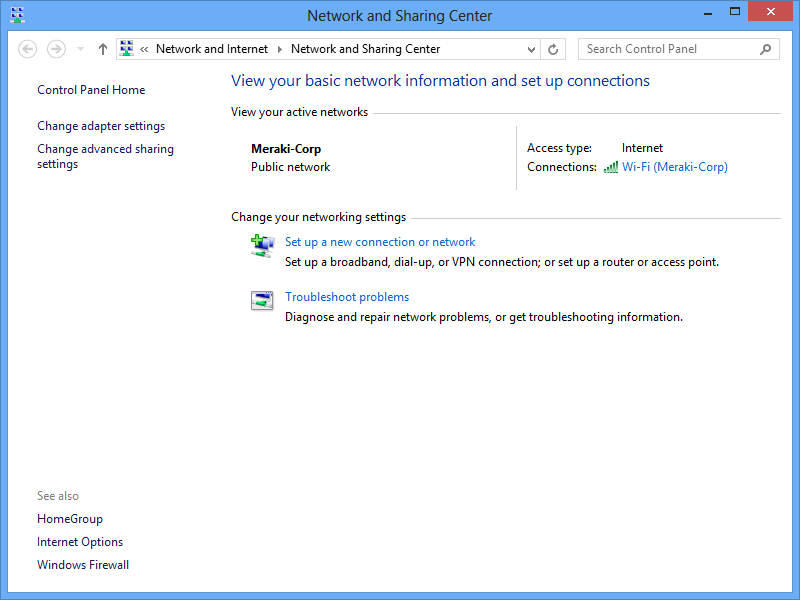
In the Set Up a Connection or Network pop-up window, choose Connect to a workplace.
(Set up a dial-up or VPN connection to your workplace)
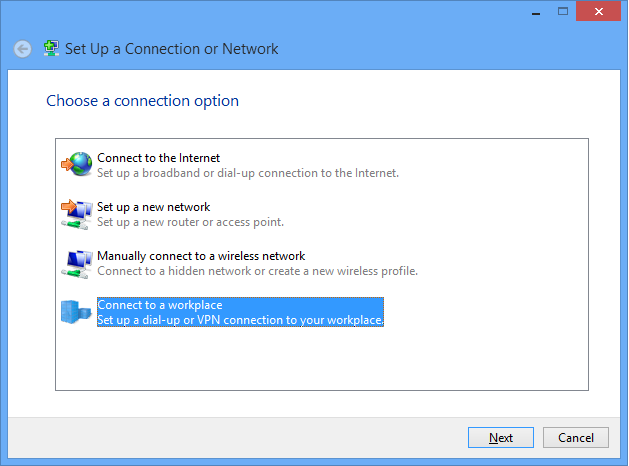
Choose Use my Internet connection (VPN), in the Connect to a Workspace dialog window.
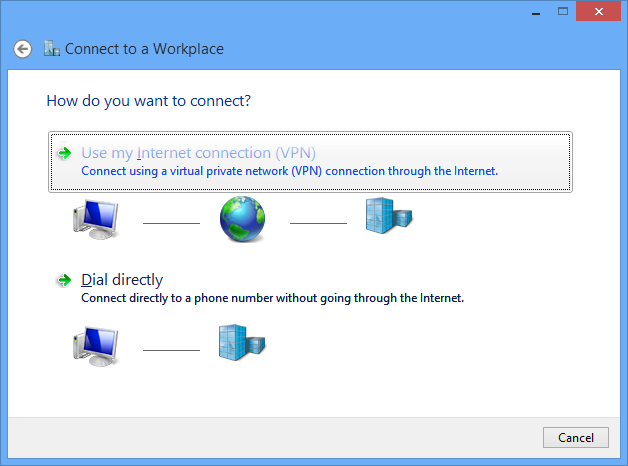
In the Connect to a Workplace dialog box, enter:
- Internet address: E nter the hostname (e.g. .com) or the active WAN IP (e.g. XXX.XXX.XXX). Hostname is encouraged instead of active WAN IP because it is more reliable in cases of WAN failover. Admin can find them in the dashboard under Security appliance > Monitor > Appliance status.
- Destination name: This can be anything you want to name this connection, for example, "Work VPN".
Click Create .
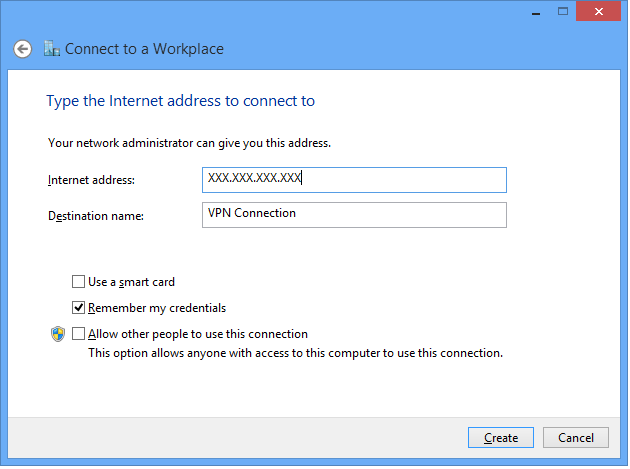
Go back to Network and Sharing Center and click Change Adapter Settings.
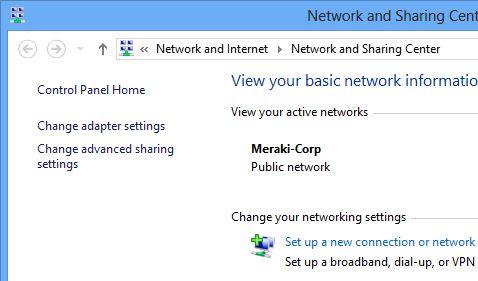
In the Network Connections window, right-click on the VPN connectionicon and choose Properties.
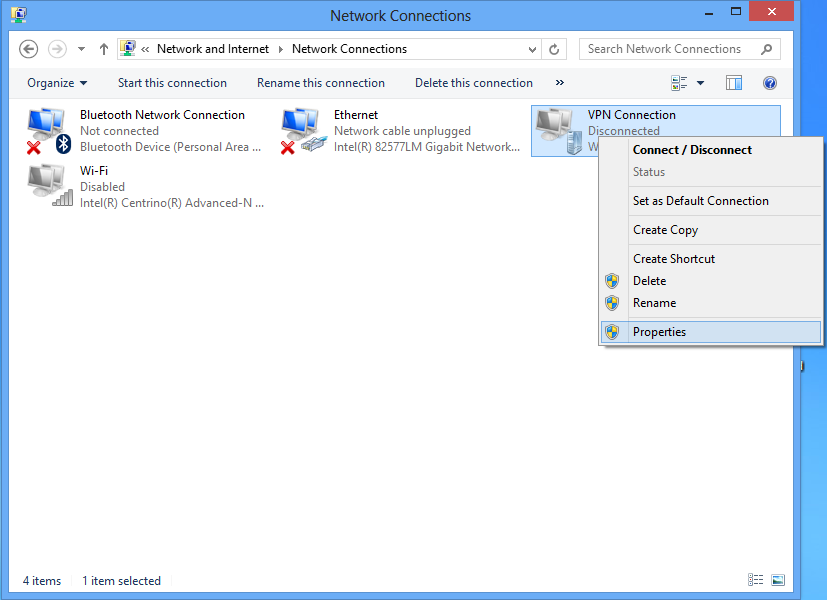
In the General tab, verify the hostname (e.g. .com) or the active WAN IP (e.g. XXX.XXX.XXX). Hostname is encouraged instead of active WAN IP because it is more reliable in cases of WAN failover. Admin can find them in the dashboard under Security appliance > Monitor > Appliance status.

In the Security tab, choose Layer 2 Tunneling Protocol with IPsec (L2TP/IPSec).
Check Unencrypted password (PAP) and uncheck all other options.
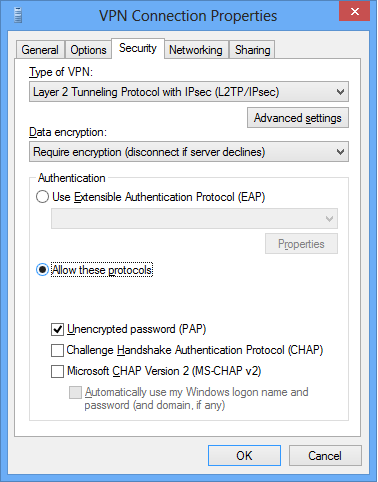
Click on Advanced settings.
Despite the name "Unencrypted PAP," the client's password is sent encrypted over an IPsec tunnel between the client device and the MX. The password is fully secure and never sent in clear text over the WAN or the LAN.
In theAdvanced Properties dialog box, choose Use preshared key for authentication and enter the preshared key that admin created in Security appliance > Configure > Client VPN settings.
Click OK.
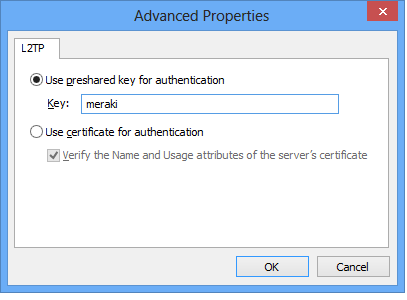
Back at the Network Connections window, right-click on the VPN connection and click Connect / Disconnect.
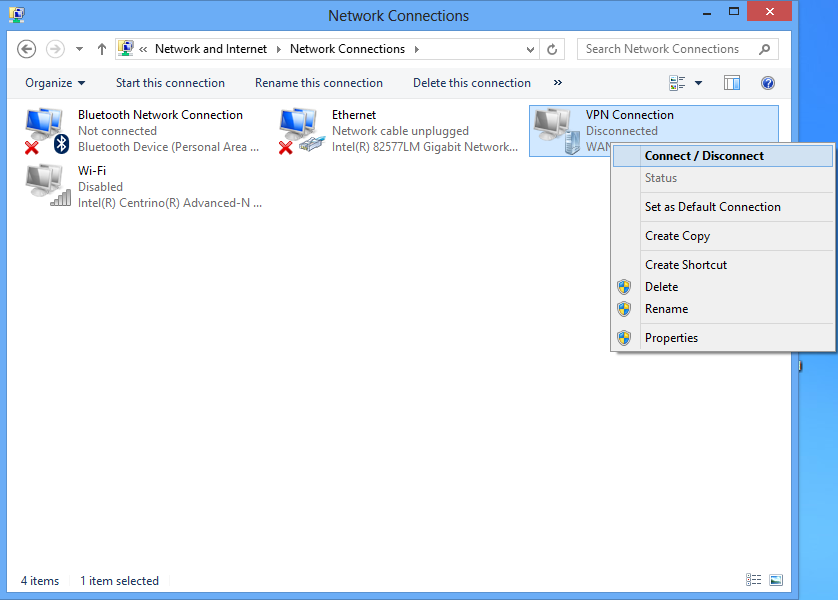
Find your VPN profile and click Connect.
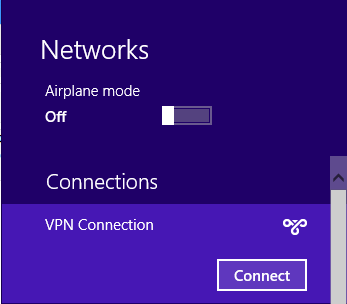
Enter your username and password.
Click OK.

Windows 10
Currently, only the following authentication mechanisms are supported:
- User authentication: Active Directory (AD), RADIUS, or Meraki-hosted authentication
- Machine authentication: Preshared keys (e.g. shared secret)
When using Meraki-hosted authentication, VPN account/username setting on client devices (e.g. PC or Mac) is the user email address entered in the dashboard.
Open Start Menu > Search "VPN" > Click Change virtual private networks (VPN)
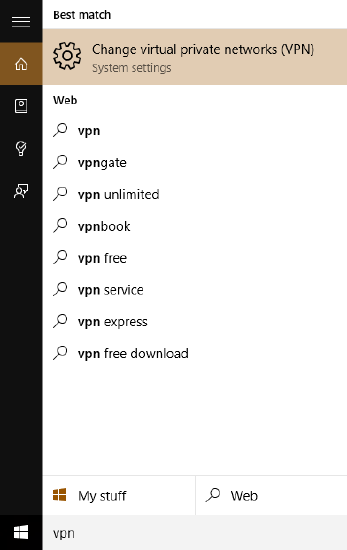
From the VPN settings page, click Add a VPN connection.
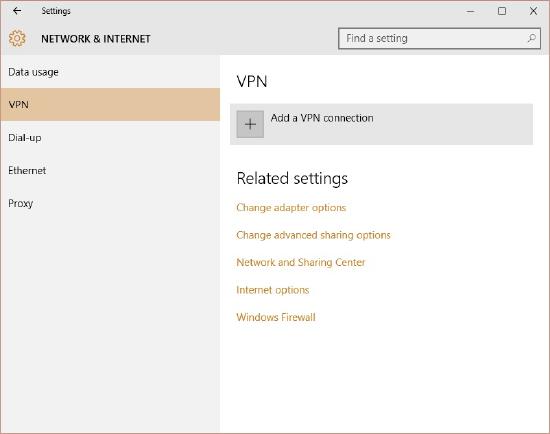
In the Add a VPN connection dialog:
- VPN provider:Set to Windows (built-in)
- Connection name: This can be anything you want to name this connection, for example, "Work VPN"
- Server name or address: E nter the hostname (e.g. .com) or the active WAN IP (e.g. XXX.XXX.XXX). Hostname is encouraged instead of active WAN IP because it is more reliable in cases of WAN failover; a dmin can find them in the dashboard under Security appliance > Monitor > Appliance status
- VPN type:Select L2TP/IPsec with preshared key
- User name and Password:optional
Press Save.

After the VPN connection has been created, click Change adapter options under Related settings.

Right-click on VPN Connection from the list of adapters and click Properties.

In the Security tab, select Require encryption (disconnect if sever declines) under Data encryption.
Then, select Allow these protocols under Authentication. From the list of protocols, check Unencrypted password (PAP), and uncheck all other options.
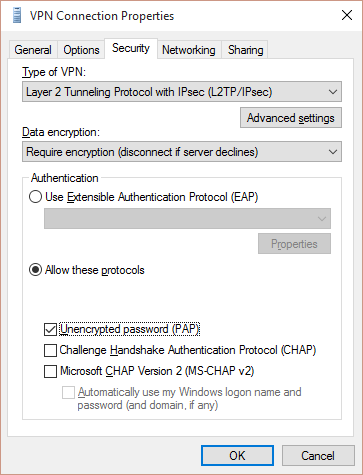
Click on Advanced settings.
Despite the name "Unencrypted PAP", the client's password is sent encrypted over an IPsec tunnel between the client device and the MX. The password is fully secure and never sent in clear text over the WAN or the LAN.
In theAdvanced Properties dialog box, choose "Use preshared key for authentication" and enter the preshared key that admin created in Security appliance > Configure > Client VPN settings.
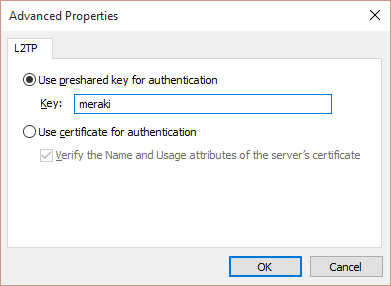
Back at the Network Connections window, right-click on the VPN connection and click Connect / Disconnect.

Find your VPN profile and click Connect.
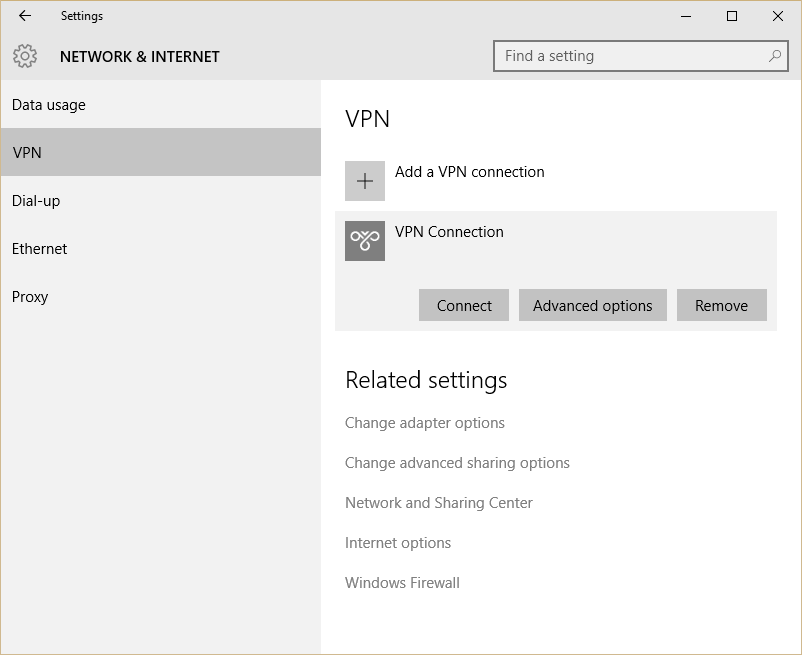
Enter your username and password.
Click OK.
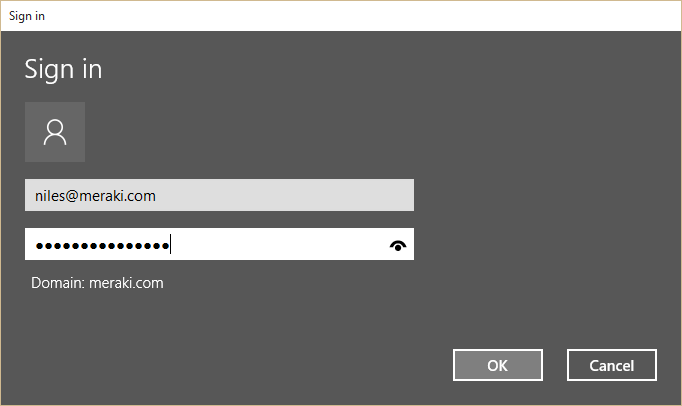
Windows XP
Currently, only the following authentication mechanisms are supported:
- User authentication: Active Directory (AD), RADIUS, or Meraki-hosted authentication
- Machine authentication: Preshared keys (e.g. shared secret)
When using Meraki-hosted authentication, use the email address for VPN account / user name.
Open Start Menu > Control Panel, click on Network Connections.
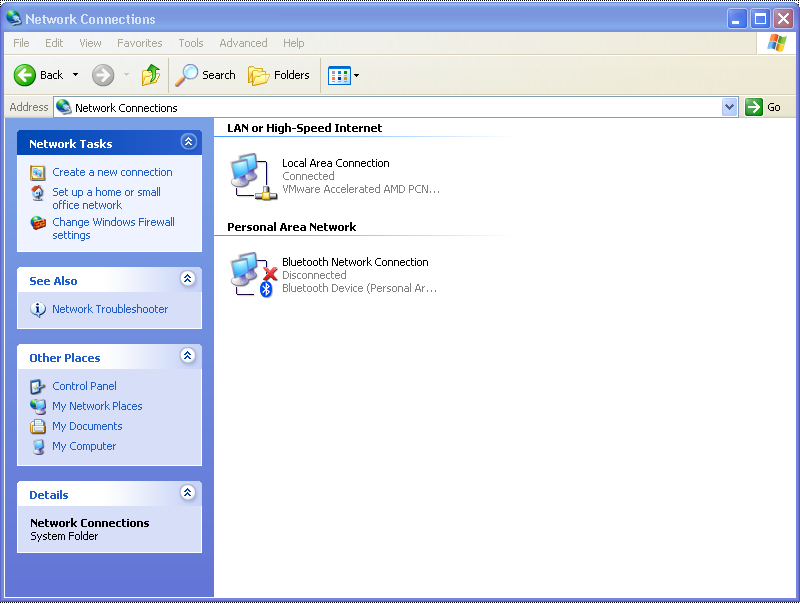
In the Network Tasks section, click on Create a new connection.
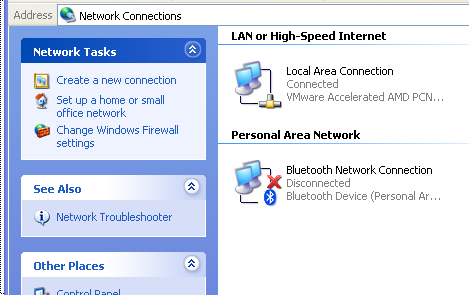
Choose Connect to the network at my workplace, in the New Connection Wizard window.
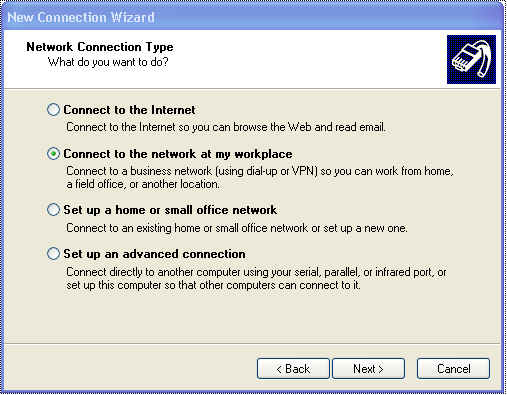
Choose theVirtual Private Network connectionin the next section.

Then, give a name for this connection. This can be anything you want, for example, "Work VPN".
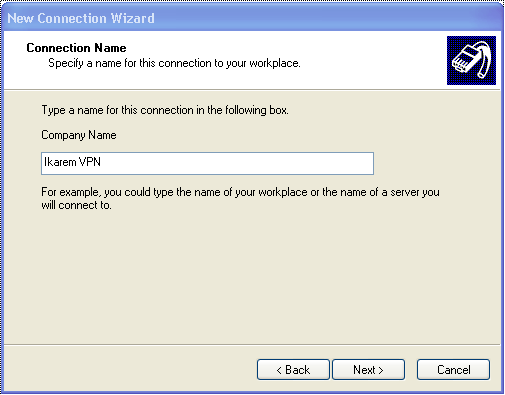
Enter the hostname (e.g. .com) or the active WAN IP (e.g. XXX.XXX.XXX). Hostname is encouraged instead of active WAN IP because it is more reliable in cases of WAN failover. Admin can find them in the dashboard under Security appliance > Monitor > Appliance status.
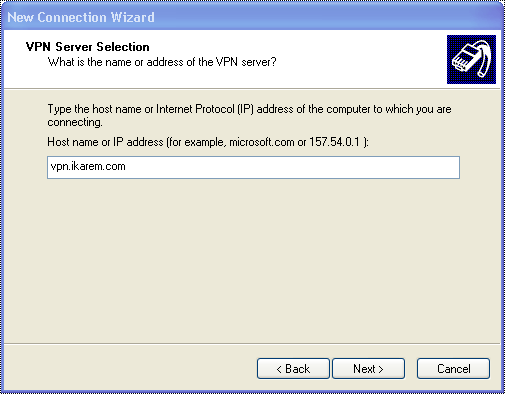
In the Connect <Connection Name> box, click on Properties:
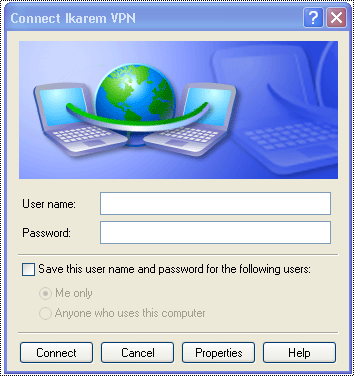
In the General tab, verify the hostname (e.g. .com) or the active WAN IP (e.g. XXX.XXX.XXX). Hostname is encouraged instead of active WAN IP because it is more reliable in cases of WAN failover. Admin can find them in the dashboard under Security appliance > Monitor > Appliance status.
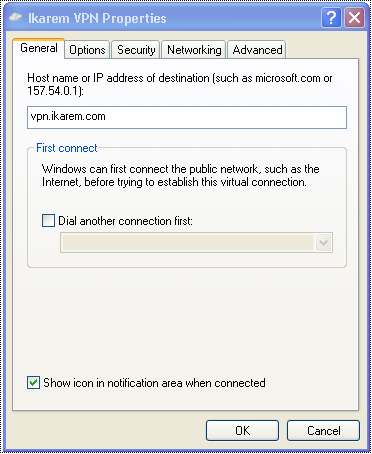
In the Options tab, uncheck Include Windows logon domain
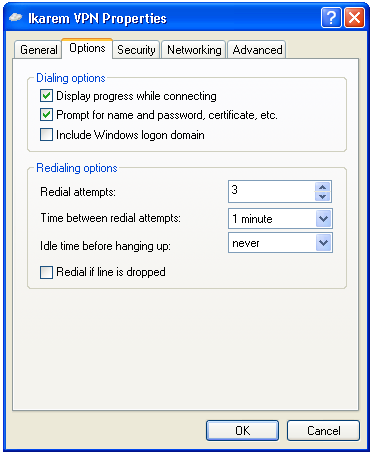
In the Security tab, choose Advanced (custom settings).
Click Settings.
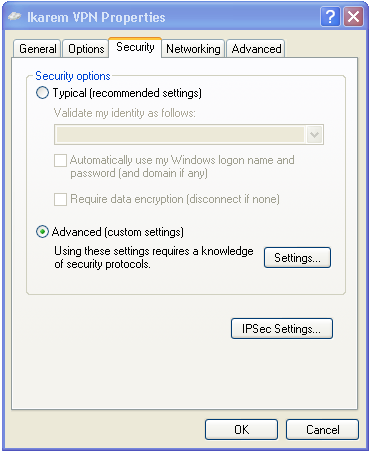
On theAdvanced Security Settings page, select Optional encryptionfrom the Data encryption pull-down menu.
Choose Unencrypted password (PAP) from the Allow these protocols options and uncheck everything else.

Despite the name "Unencrypted PAP", the client's password is sent encrypted over an IPsec tunnel between the client device and the MX. The password is fully secure and never sent in clear text over the WAN or the LAN.
Back on the Security tab, click IPSec Settings.
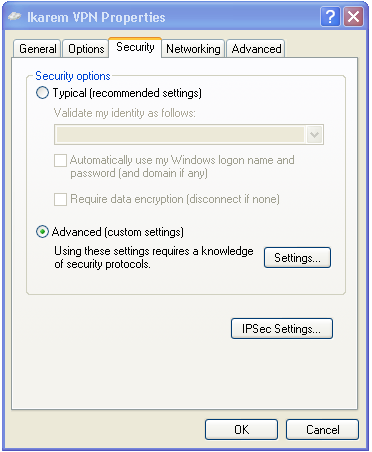
Check Use pre-shared key for authentication and enter the preshared key that admin created in Security appliance > Configure > Client VPN settings.
Click OK.
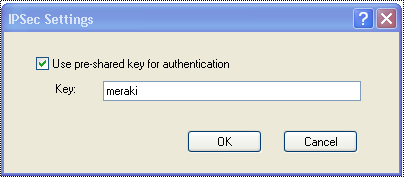
In theNetworking tab, choose L2TP IPSec VPN from the Type of VPN options.

Back at the Network Connections window, right-click on the VPN connection and click Connect.
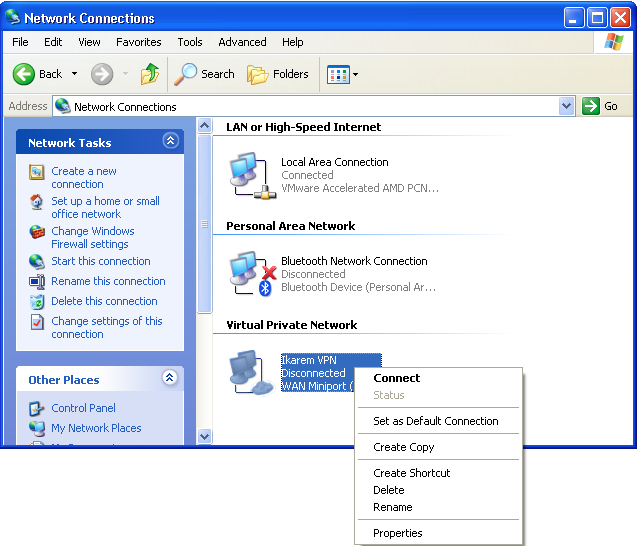
Verify your username and click Connect.

Linux
Since client VPN uses the L2TP over IPsec standard, any Linux client that properly supports this standard should suffice. Please note that newer versions of Ubuntu do not ship with a VPN client that supports L2TP/IP, and will therefore require a third-party VPN client that supports the protocol.
Note: The xl2tp package does not send user credentials properly to the MX when using Meraki Cloud Controller authentication, and this causes the authentication request to fail. Active Directory or RADIUS authentication can be used instead for successful authentication.
Configuring Ubuntu 20.04
Ubuntu does not support L2TP VPN by default. You will need to install a couple of software packages to enable this functionality. The instructions below were written for Ubuntu 20.04 LTS with the Gnome desktop environment. Ubuntu versions 16.04 and 18.04 can be configured in a similar manner. However, due to the large number of Linux versions available, it is not feasible to document every supported Ubuntu version.
In order to begin the VPN setup, open a terminal window. Do this by searching for Terminal in your application list. Click on the Terminal icon to open a new session.

Once the terminal window appears, you will need to enter a few commands:
sudo apt-get update sudo apt-get install network-manager-l2tp sudo apt-get install network-manager-l2tp-gnome

Note: You will need to be part of the "sudoers" group to install these packages. If you receive an error message like "<username> is not in the sudoers file" you will need to either adjust your permissions, contact your administrator to add your account as an administrator, or have them install the software for you.
Once the packages have been installed, you may open up the Network Settings by searching for Settings in the application list, or by clicking on the Network icon at the top right of the screen and selecting Wired (or Wireless) Settings.
![]()
Once the Network Settings window pops up, you will see there is a VPN section listed. Click on the + icon to set up a new VPN connection.
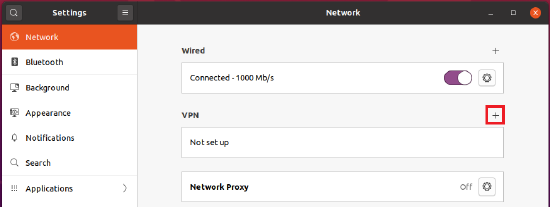
Select the Layer 2 Tunneling Protocol (L2TP)VPN type on the modal pop-up window. If L2TP is not listed as an option, please see the first step about installing the required packages.

After selecting the L2TP option, a new modal will pop up titled Add VPN. Fill out the Name, Gateway, User name, and Password fields here.

Note: To save your password on this screen, you must select the appropriate option from the question mark on the password field.

Next, click on the IPsec Settings button to open the L2TP IPsec Options modal.

Once the modal pops up, expand the Advancedoptions, and enter the following:
Pre-shared key: Enter the pre-shared key from Security & SD-WAN > Configure > Client VPN Phase1 Algorithims: aes128-sha1-modp1024,3des-sha1-modp1024! Phase2 Algorithims: aes128-sha1-modp1024,3des-sha1-modp1024!
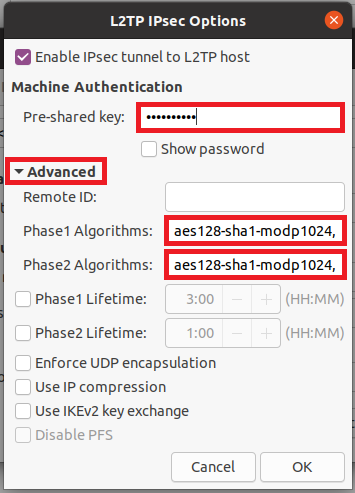
Select OKto continue. You will be returned back to the Add VPN modal. Select the PPP Settingsbutton.

On the L2TP PPP Options modal, select only the PAP authentication method. Be sure the other authentication methods are de-selected. All other options can remain as the default. Select OK to continue.
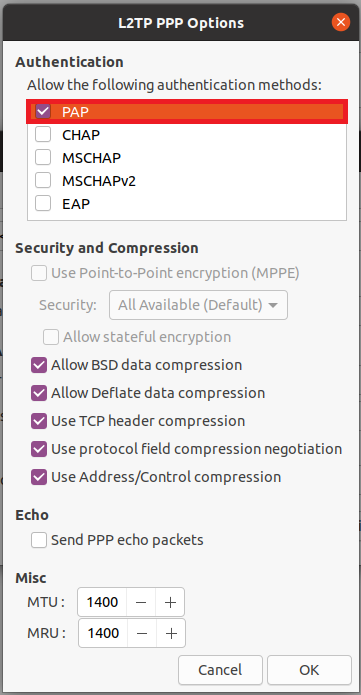
Select Add in the top-right corner of the Add VPN modal to complete the VPN setup.

Now you may connect your VPN by toggling the button on the Network Settings page:

Or by selecting the Connect option from the top-right-corner menu.
![]()
Upon successful connection, a VPN icon will appear next to the network icon in the status bar.

Note: The version of network-manager-l2tp that is installed along with xl2tpd is known to cause issues when connecting to Meraki appliances. To alleviate this, you must disable the xl2tpd service when using the network-manager GUI to connect to a Meraki VPN.
To stop the xl2tpd service once, use this Terminal command:
sudo service xl2tpd stop
To stop the xl2tpd service for all subsequent reboots, use this Terminal command:
sudo update-rc.d xl2tpd disable
How to Setup L2tp Vpn on Windows Xp
Source: https://documentation.meraki.com/MX/Client_VPN/Client_VPN_OS_Configuration